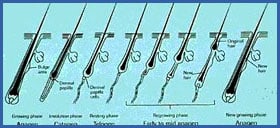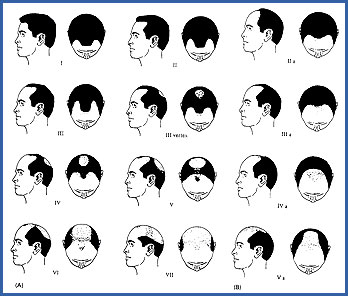In this FAQ, you will find answers to commonly asked medical questions about the surgery, controversial issues, and subjects you might not have even considered. If you have a question that still has not been answered, please contact us today to have your specific questions answered directly. For your convenience, FAQ section is divided into several parts.
I want to learn more about normal hair growth.
A terminal scalp hair will typically grow 1 cm per month for 2-6 years in the “Anagen” phase then over 2-4 weeks it will go through a transition phase, called the “Catagen” phase, at the end of which begins a resting phase, called the “Telogen” phase, which lasts for 2–4 months. In the Catagen Phase the “root” or dermal papilla shrinks and migrates upward toward the surface of the skin. The hair in the Telogen Phase is club-shaped and does not have the full ball or root that an Anagen hair has.
 The hairs you see every day on your brush or pillow, or in your shower or sink are those that are shed in the Telogen Phase. They will be replaced by new, growing Anagen hairs. Research is being done to determine what controls this growth cycle but there is still much to learn.
Most people(including many doctors)believe that hair grows in single strands very closely together. It doesn't !
The hairs you see every day on your brush or pillow, or in your shower or sink are those that are shed in the Telogen Phase. They will be replaced by new, growing Anagen hairs. Research is being done to determine what controls this growth cycle but there is still much to learn.
Most people(including many doctors)believe that hair grows in single strands very closely together. It doesn't !
 A magnified look at scalp hair that has been trimmed to 1 – 2 mm long will show you that, in fact, hair grows in small "bundles" of 1,2,3, occasionally 4, and rarely 5 hairs per "bundle". These hairs, along with their accompanying support system (sebaceous glands, erector pilae muscle etc.) form what is now known as the "Follicular Unit".
These 1-5 hair "bundles" usually exit the scalp through just a single pore! When examined under a powerful microscope, these "Follicular Units" are clearly distinct anatomical entities, “individually wrapped” by a layer of (connective) tissue.
Follicular Unit Transplantation requires the precise dissection of each Follicular Unit, keeping all of its elements intact. This ensures optimal survival and growth of the hair and properly transplanted follicular units are indistinguishable from naturally occurring follicular units. Using nature’s own building blocks for hair transplantation with follicular unit hair transplantation provides reliably good, natural results.
A magnified look at scalp hair that has been trimmed to 1 – 2 mm long will show you that, in fact, hair grows in small "bundles" of 1,2,3, occasionally 4, and rarely 5 hairs per "bundle". These hairs, along with their accompanying support system (sebaceous glands, erector pilae muscle etc.) form what is now known as the "Follicular Unit".
These 1-5 hair "bundles" usually exit the scalp through just a single pore! When examined under a powerful microscope, these "Follicular Units" are clearly distinct anatomical entities, “individually wrapped” by a layer of (connective) tissue.
Follicular Unit Transplantation requires the precise dissection of each Follicular Unit, keeping all of its elements intact. This ensures optimal survival and growth of the hair and properly transplanted follicular units are indistinguishable from naturally occurring follicular units. Using nature’s own building blocks for hair transplantation with follicular unit hair transplantation provides reliably good, natural results.


What is considered Normal Hair Loss?
Most hair loss is normal and part of each person's individual genetic makeup. We lose hair everyday. Hair grows for a period of time, usually for 2 to 6 years, and then the follicles shed the hair and go into a resting stage for approximately 3 months, then a new hair growth cycle begins. It is normal to lose between 50 to 150 hairs per day from normal hair shedding.
Speake a little about gentic hair loss in men?
Androgenetic alopecia is the scientific name for the genetic predisposition in both men and women for pattern baldness. Pattern hair loss in men is often referred to as male pattern baldness(MPB). Androgenetic alopecia is the cause of over 95% of all pattern hair loss, including baldness in men and thinning hair in women. Pattern hair loss occurs in somewhat predictable stages, and is relentlessly progressive. Usually the earlier in life pattern hair loss begins the more advanced the hair loss pattern will ultimately become. Studies have shown that pattern loss is increasingly evident and advanced as people age.
 In MPB the hairs on the top of the scalp have a genetic sensitivity to the male hormone testosterone (DHT). DHT is believed to contribute to:
In MPB the hairs on the top of the scalp have a genetic sensitivity to the male hormone testosterone (DHT). DHT is believed to contribute to:

- Shortening of the growing phase of the hairs,
- Progressive miniaturization of hair follicles,and
- A decrease in the number of visible hairs
Does stress play any role in Hair Loss?
Stress can speed up the rate of hair loss. Although it usually does not cause permanent loss in an area not meant to bald, it can considerably speed up the time frame in which genetically doomed hair dies.
Stress such as the loss of a loved one can similarly speed up hair loss. Physical stress such as heavy athletic training as well as even the simple stress of moving to a new country with a new language can push the fast forward button on male pattern hair loss. It's important to understand that stress can help cause hair loss other than that determined by heredity. We see this in alopecia areata as well as other more dramatic forms of baldness, such as that which occurs during chemotherapy. What is important to remember is that with the exception of hereditary and exotic causes for balding, hair will generally grow back.
Why start now?
If you have been determined to be a candidate for restoration by a NHI physician, and if you are uncomfortable with your hair loss, why not start now? With your restoration completed, you can get on with life without this distraction.
Is it better to begin early?
A hair transplant should begun when your degree of hair loss is unacceptable to you. Not when you are only worried about future loss or "So no one will notice." Starting early will often require multiple small sessions, and your expectations may be unrealistic.
How much hair do I have?
The Norwood classifications were adapted from the patterns described by Dr. O'Tar Norwood. There are seven classes of hair loss in the main series and five variations of these classes called the 'A' series. If you compare your hair loss pattern with these diagrams, you can probably see the pattern you are in now. Discussion with one of NHI's knowledgeable physicians can help you determine how extensive your hair loss may become. Please see Assessing Your Hair Loss for more info.
How much hair do I need?
When you have your consultation with a NHI physician, he will suggest how many grafts may be available for your first procedure (and subsequent procedures if they will be needed). This number will be based on your present balding pattern, what it may become in the future, and how much donor hair is available. When an individual has high donor density, the follicular units usually contain multiple hairs, and when an individual has low donor density the follicular units often contain only one hair. If an individual has a very loose scalp, a larger donor strip can be removed, while an individual with a tight scalp will have a smaller donor strip. When an individual has a relatively small amount of hair that can be moved, our physicians take great pains to distribute the available hair in ways that produce the best coverage. Please see Assessing Your Hair Loss for more info.
What is the difference between density and fullness?
The word fullness rather than density, more accurately describes the visual phenomenon in what we perceive as thick hair vs. thin hair. The concept of fullness is broader and more inclusive. Density, the number of hairs/cm2, is only one of several contributing factors that are responsible for the visual impression of hair that appears "thick". Other factors include hair shaft diameter, color, texture, and curl, which may be of equal of even greater importance than density, in contributing to the visual appearance of a "full" head of hair.
In the early stages of balding the "thin look" is caused by a process called "miniaturization" where hair is reduced in size, but not actually lost. Therefore, the density (the counted number of hairs/cm2) remains the same, although the persons look of fullness can be dramatically reduced.
What is a typical Hair Transplantation Surgery day like?
The patient signs a consent form for surgery.
Antibiotics are given to prepare for surgery.
The area for transplantation is confirmed and the new hairline design is drawn onto the scalp.
Photo documentation.
The patient enters the operating room and changes into surgery clothes.
The patient sits, relaxes, and listens to music while the heart rate, blood pressure and oxygen saturation are carefully monitored.
It will take our surgical team about four to 4 hours to perform a 1000-graft session, 5 hours for a 1500 graft session. Each patient receives the full attention of our staff.
The patient is given local anesthesia with or without a mild sedative intravenously.
Hair is taped up in the back to allow access to the selected area of hair-bearing donor scalp. A thin strip of the permanent hair along the lower back of the scalp is used. Afterwards, this thin scar will be easy hidden underneath the surrounding permanent hair.
Using a very fine 30 gauge needle, the scalp is anesthetized. Once the scalp is numbed, the surgery is virtually painless as the nerves are blocked.
After the fine strips of hair are removed from the back of the scalp, the technicians divide them into the predetermined sizes of grafts using a video visualizer or a stereoscope.
The back of the scalp is sutured by the surgeon. This scar will be barely detectable in a few months and will be completely hidden by hair growth.
The grafts are now ready to be transplanted into the "recipient" area. Mini-slits are made for the modified follicular grafts (2 to 4 hairs) while 19 gauge needle holes are made for the micro grafts (1 to 2 hairs.) We are able to accomplish several thousand hair grafts in one session. Two to four surgical technicians begin implanting the grafts. This part of the procedure can last between 2 to 4 hours.
After all grafts have been completed and checked, the donor and recipient areas are cleaned and the donor area only is bandaged. The patient is given a list of post-operative instructions and medications. If I.V. sedation is used, the patient must not drive home himself. It will be necessary to arrange for transportation home prior to arrival at the clinic.

